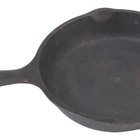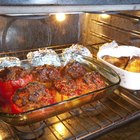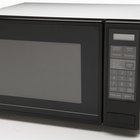
Casseroles have many virtues. They're a convenient one-pot meal, they stretch leftover ingredients, they're conducive to preparing and serving food to a crowd and they prominently feature cheese, to name a few. However, oven-cooking everything in one big dish has its downside -- namely, it takes much longer than an impromptu supper on the stovetop. If your recipe instructions are unclear, covering casseroles can affect cooking times in general and for different ingredients.
Covering Casseroles 101
In general, covering a casserole dish will cook the food faster. This is because the lid traps the heat that rises off the food instead of letting it dissipate into the oven. Covering also has the effect of moistening the food inside, like steaming, because any moisture that rises off the food is trapped by the lid. Things cook faster and more evenly, because all layers -- including the top -- are exposed to high heat.
The Top Layer
It's always best to follow the recipe, but if you are lacking specific instructions regarding covering the dish, think about what you're cooking inside the casserole dish. If you've sprinkled the top with cheese, breadcrumbs, butter or some other form of a crunchy topping, don't cover it. The top is meant to get brown and crispy. If you're cooking vegetables or meat without a crust or without instructions to baste them with juices, covering the dish helps keep everything moist.
Even Cooking
Covering casseroles helps everything cook evenly. Otherwise, the outside is exposed to higher heat, causing it to burn or dry out while the inside may not be fully cooked. This is especially relevant for meat dishes. Depending on your recipe, consider covering the dish for part of the cooking time and then uncovering near the end to get a slightly browned, crispy crust. If you're cooking small chunks of meat coated in sauce, covering may be less essential to even cooking.
Additional Considerations
Before covering your casserole, consider what you are covering the dish with, whether any of the food was cooked beforehand and what material your dish is made of. Covering loosely with aluminum foil will trap less heat than an airtight ceramic cover. If you're baking a casserole with raw vegetables, covering it will ensure even, moist cooking; this may be less essential if you cooked the vegetables before adding them to the casserole. Ceramic and glass pans conduct heat well but may cause over-browning, in which case you may want to remove the cover partway through cooking. The same is true for dark metal pans, which over-brown easier than light, shiny metal pans.
Related Articles

Do I Cover or Uncover When Baking?

Are Nickel Lined Pans Safe?

The Positive Effects of Using a ...

Can You Reheat Pheasant?

How to Use an Iron Skillet on a Ceramic ...

How to Cook With Saran Wrap

How Does a Convection Oven Work?

How to Cook With a Gas Fireplace

Can You Cook Something Frozen in the ...

The Steps in Cooking Raw Foods in a ...

Why Does Food Stick to a Non Stick Pan?
Can You Oven Cook With Pottery?

How to Make Teriyaki Sauce

How to Use a Bamboo Steamer

Hamilton Beach Panini Directions

How to Cook Chicken in a Schlemmertopf ...

How Long Does It Take for Asparagus to ...

How to Cover Up Unused Exterior Windows

What Are the Dangers of Cooking With ...
How to Lower Cooking Times & ...
References
Writer Bio
Based in Chicago, Ginger O'Donnell has been writing education and food related articles since 2012. Her articles have appeared in such publications as "Dance Teacher Magazine" and "Creative Teaching and Learning." In addition, Ginger enjoys blogging about food, arts and culture on swirltocoat.com. She holds a Bachelors of Arts in Performance Studies from Northwestern University and a Masters of Arts in Teaching from Webster University.
Photo Credits
Eising/Photodisc/Getty Images